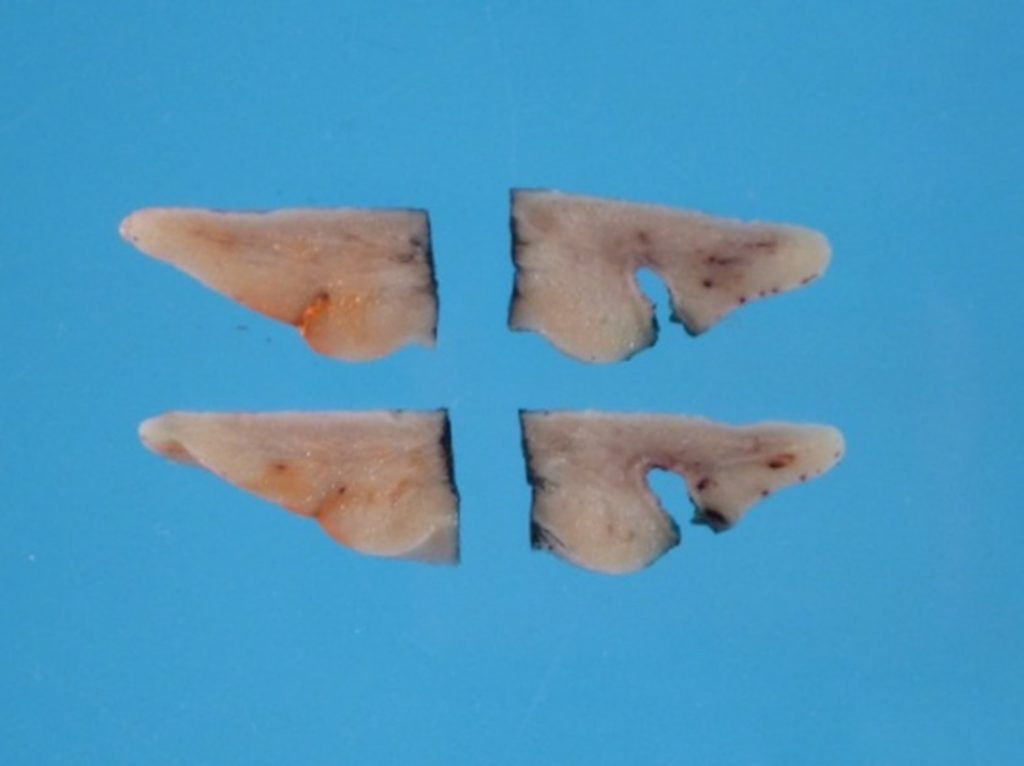Robot + CO2 Laser: A Dual Tool Against Rising HPV-Related Head and Neck Cancers
By Ron J. Karni, MD
Lasers and surgical robots are indispensable technologies that become something even greater when used together for minimally invasive transoral cancer surgery. ENT surgeons adopted CO2 lasers decades ago in order to make more precise cuts and minimize harm to surrounding structures (e.g., when removing a tumor located adjacent to a critical structure such as a vocal cord or nerve). In the head and neck, we usually don’t have a lot of real estate to spare in order to deliver a clear margin, so we prefer to make very accurate, delicate cuts. It is well established that the laser causes much less collateral tissue artifact in comparison to the wide zones of destruction caused by classic cauterization (Image 1). This means that for the purposes of delivering a clear margin, much less tissue has to be removed or destroyed when the laser is used.

When surgical robots first appeared over a decade ago, they offered the capability of working with four articulating hands, as well as impressive 3D endoscopic visualization. But the robotic instrument arms were initially limited to cautery. Soon thereafter, lasers were adapted to the robotic surgery platform, bringing the advantages of both modalities to the operating room.
When it became possible to pair the robot with a CO2 laser, it opened up new options for treating head and neck cancers, just at the time that we began to understand the rising prevalence of human papillomavirus (HPV) as a cause (Sabatini & Chiocca, 2020). Today, it’s common to see younger, healthier patients with HPV-related cancer, and surgical techniques are rising to meet the challenge. Rather than sending all patients for traditional dosing of chemotherapy with radiation, many patients can undergo transoral robotic surgery with laser, often followed by markedly lower doses of radiation (Miles et al., 2021). The advantages of surgery followed by less (and sometimes no) radiation and chemotherapy are well demonstrated (Miles et al., 2021). Patients have better swallow outcomes, which means fewer patients are dependent on feeding tubes in the short and long term (Ozturk et al., 2021). There is also a trend toward improved overall survival in patients who undergo surgery in this manner (Ozturk et al., 2021; Howard et al., 2016).
Clear advantages
The pairing of robotic and laser techniques is essential to my work as a head and neck surgeon, allowing me to routinely perform complex excision of cancerous lesions with exacting precision. Patients gain significant benefits from this approach, and these technologies are accessible to most hospitals.
Margins for success: When surgeons excise cancer, we remove the tumor with a margin of surrounding cells to ensure we get it all. The pathologist examines these surrounding healthy cells under the microscope to make sure the entire tumor was removed. In areas with lots of space and few critical organs, such as the skin of the back or leg, that margin may be more than 1 cm, but for tumors in and near the pharynx (throat) and voice box (the supraglottic larynx, epiglottis, vocal cords, false cords, and aryepiglottic folds), collateral damage to surrounding tissues can be devastating. Using a CO2 laser and robot, I can cut close to the tumor but still have a demonstrable clear margin, which was never possible with the wide-cutting cautery pen. Furthermore, the CO2 laser allows to us remove tumors either en bloc (in one piece), or to make transtumoral cuts to remove bulkier tumors piecemeal while still clearly seeing the interface between the tumor and the margin.
Easier recovery, expanded access to surgery: By combining the CO2 laser’s minimally destructive nature with the robot’s enhanced access and visibility, the laser-robot combination expands the percentage of head and neck cancer patients who can receive surgery. Instead of radiation and chemotherapy, patients can undergo surgery and have less radiation or even no radiation.
Low cost per case: Both CO2 lasers and surgical robots are used across multiple surgical specialties and the cost per case is amortized over time, so the cost is often several hundred dollars for each technology. The total cost of care for a head and neck cancer patient’s treatment is less when transoral surgery is part of the treatment plan.
For surgeons, there’s no denying that the crystal-clear 3D view of robotic surgery is exciting. When we combine it with the precision cutting of the CO2 laser, we can help more patients than ever before experience the advantages of minimally invasive surgery for head and neck cancers.
Ron J. Karni, MD, is an assistant professor in the Department Otorhinolaryngology-Head and Neck Surgery at McGovern Medical School at UTHealth, Houston.
References
Howard, J., Masterson, L., Dwivedi, R. C., Riffat, F., Benson, R., Jefferies, S., Jani, P., Tysome, J. R., & Nutting, C. (2016). Minimally invasive surgery versus radiotherapy/chemoradiotherapy for small-volume primary oropharyngeal carcinoma. Cochrane Database of Systematic Reviews. https://doi.org/10.1002/14651858.CD010963.pub2
Miles, B. A., Posner, M. R., Gupta, V., Teng, M. S., Bakst, R. L., Yao, M., Misiukiewicz, K. J., Chai, R. L., Sharma, S., Westra, W. H., Kim-Schulze, S., Dayal, B., Sobotka, S., Sikora, A. G., Som, P. M., & Genden, E. M. (2021). De-escalated adjuvant therapy after transoral robotic surgery for human papillomavirus-related oropharyngeal carcinoma: The Sinai Robotic Surgery (SIRS) trial. The Oncologist, 26(6), 504–513. https://doi.org/10.1002/onco.13742
Ozturk, K., Turhal, G., Durusoy, D., Sahin, E., Akagunduz, O., Eyigor, S., Akyildiz, S., & Esassolak, M. (2021). Long-term swallowing outcomes of radiotherapy and transoral laser microsurgery for T1 glottic cancer treatment. Clinical Otolaryngology, 46(2), 340–346. https://doi.org/10.1111/coa.13674
Sabatini, M. E., & Chiocca, S. (2020). Human papillomavirus as a driver of head and neck cancers. British Journal of Cancer, 122, 306–314. https://doi.org/10.1038/s41416-019-0602-7
